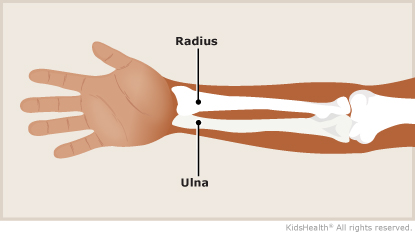A Broken Wrist: How to Care for Your Child
At today's visit, the health care specialist checked your child's arm and X-rays. Your child has fractures in both the radius and ulna bones at the end where they join the wrist. A splint was put on your child's arm. After a few days, when the swelling goes down, the splint will be replaced with a cast. Healing time varies, but kids usually need a cast for 4–6 weeks.


Daily splint care:
-
Don't remove or change the position of the splint.
-
Remind your child to wiggle the fingers to keep blood circulating normally.
-
Check the area around the splint every day. Make sure the skin isn't scratched and the fingers aren't pale, blue, numb, or tingling.
-
Make sure your child doesn't pick at the lining of the splint or scratch under the splint.
-
Don't put anything in the splint. Make sure your child doesn't put toys, food, or other objects into it.
-
Keep dirt, sand, lotion, and powder away from the splint.
-
If given a sling, your child should use it when up and walking around. Do not let your child wear the sling while sleeping.
-
Keep the splint dry:
-
No swimming.
-
Give sponge baths to kids younger than 5 years old.
-
Older kids should take baths instead of showers.
-
Put a plastic covering over the splint when your child bathes. Put the arm and splint on something to keep them completely out of the water.
-
If the splint is accidentally splashed, gently blow air onto it from a hair dryer on the cool setting.
Problems to watch for:
-
Itching: Tap lightly on the splint or use a hair dryer on the cool setting to blow air in and around the edges.
-
Swelling: If the fingers look puffy, raise the arm above the level of the heart for 1 hour. If the swelling doesn't get better, call your health care provider.
If your child has pain:
-
When your child is awake, apply ice in a plastic bag wrapped in a towel on the outside of the splint for 20 minutes every 3 hours for up to 2 days. Don't put ice directly on the splint or skin.
-
You can give medicine for pain if your health care provider says it's OK. Use these medicines exactly as directed:
-
acetaminophen (such as Tylenol® or a store brand)OR
-
ibuprofen (such as Advil®, Motrin®, or a store brand). Do not give ibuprofen to babies under 6 months old.
Be sure to:
-
Follow up with the orthopedic specialist as recommended.
-
Have your child avoid gym class, sports, and playground equipment and activities until the orthopedic specialist says it's OK.

-
Your child's pain continues while taking pain medicine.
-
The pain becomes worse, especially when your child stretches out the fingers.
-
Your child's fingers stay swollen even after propping up the arm for 1 hour.
-
Your child develops a fever without an obvious reason (like an ear infection or sore throat).
-
The splint feels too tight or too loose.
-
The splint becomes damaged, wet, or smelly.

-
Your child's hand becomes tingly, numb, cold, blue, or pale.

What are the radius and ulna bones? They are the bones in the lower arm. The ulna is on the little finger (pinkie) side. The radius is on the thumb side.
What causes arm fractures? Often, arm fractures happen when kids hold out their arms to stop a fall. The pressure on the bone causes it to crack, usually at the end near the wrist.
What's the difference between a splint and a cast? Both support and protect the broken bone while it heals. In a cast, the hard part goes all the way around the arm. But in a splint, the hard part only goes partway around the arm. This allows space for swelling. Splints and casts can feel heavy, so your child may have had a sling placed around the neck and over the splint for support.